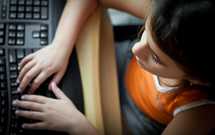Flipped learning, a growing instructional model, helps educators personalize instruction for students
 Supporters of flipped learning have proven that the instructional model is more than just a fad. As it spreads to classrooms across the nation, educators are leveraging the flipped model to create a more personalized and engaging learning environment for their students.
Supporters of flipped learning have proven that the instructional model is more than just a fad. As it spreads to classrooms across the nation, educators are leveraging the flipped model to create a more personalized and engaging learning environment for their students.
During an ASCD webinar sponsored by Adobe Presenter, flipped learning leaders Jonathan Bergmann and Aaron Sams discussed multiple ways that a flipped classroom can lead to increased student engagement and personalized learning.
“We believe that good teaching is good when it has good relationships in it,” Bergmann said. “Relationships matter. We believe good teaching happens in the context of good relationships with kids.”
Flipped learning supports this kind of relationship by giving teachers and students more face-to-face interaction. This occurs due to the instructional method’s structure, which shifts content delivery outside of the classroom in the form of teacher-created videos and makes room for “homework” in class, giving students and teachers a chance to discuss problems and explore concepts.
(Next page: Challenges–and solutions–around flipped learning)
“I believe we need to move from the teacher-centered classroom and move to classrooms that are project-based and inquiry-driven,” Bergmann said.
Educators can think of flipped learning as a reevaluation of Bloom’s Taxonomy in which the focus lies more on creating, evaluating, and analyzing.
“You, as a teacher, get the attention away from yourself and away from content delivery—you leverage technology of a teacher-created video to deliver content,” Sams said.
Top educator concerns about moving to flipped learning are so common that Bergmann and Sams created the Four Ts to help educators realize that a flipped classroom can become a reality.
Thinking: Flip teachers’ thinking and help them re-imagine what the classroom looks like, Bergmann said. It’s not about content dissemination—it’s about deeper thinking.
Time: Lots of teachers are worried about how much time it takes to flip a class, and then they worry about what they’ll do with their class time if they’re no longer delivering direct instruction. “There is a decent amount of up-front work you have to do to get it going,” Sams said. “But you can recycle your video content for 3-5 years. Yes, there is some work, but carve the time out, and make it happen.” Sams and Bergmann advised educators to attend their national subject-area conferences, such as the National Science Teachers Association or the National Council of Teachers of Mathematics conferences. “You’ll have subject area experts explaining all sorts of amazing things, and you’ll wonder when you’ll have time to do them—you’ll get that time back [when you flip your classroom], and you’ll be able to do some of that cool stuff,” Bergmann said.
Technology: New software makes it easy for educators to create content, and screen casting tools make it even easier–whatever is on the computer screen is recorded for distribution or viewing. Bergmann uses Adobe Presenter 10.
Training: Seeking out online resources, such as flippedclass.com and flippedlearning.org, can help educators as they begin to flip their classroom, and again as they delve deeper into flipped learning and expand their flipped instructional practices.
And what about the students who do not have access to technology outside the classroom?
“It’s an absolutely legitimate question, but it’s not something that should stop you,” Sams said. “It’s something that should be solved. If you’re going to require students to access digital content outside of your class, you have to provide them with a way to access it.”
Putting created content on flash drives or DVDs is one option. Another is using school funds or grant money, or soliciting donations from parents or local businesses, to purchase iPods or other devices students can check out to use for flipped lessons. Schools could open libraries early, or extend hours after school, or staff libraries during lunch so that students can use school resources to work on flipped lessons.
“This is a legitimate concern, but I bet you can figure out a solution to it,” Sams added.
Others wonder if flipped learning will prompt students to skip class because they have access to lectures and videos on their own time. While this is more of a higher-ed concern, Bergmann and Sams noted that part of flipping a classroom involves making in-class time engaging and exciting so that students want to come to class to discuss and explore the concepts they’ve learned about at home.
“The flipped classroom actually makes teachers more valuable,” Bergmann said. “It moves us from being content disseminators to being facilitators of learning.”
- Friday 5: Virtual field trips - April 26, 2024
- Google, MIT RAISE launch no-cost AI training course for teachers - April 26, 2024
- 4 ways to support work-based learning - April 23, 2024
